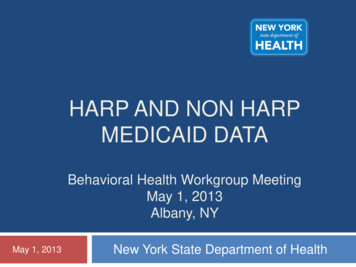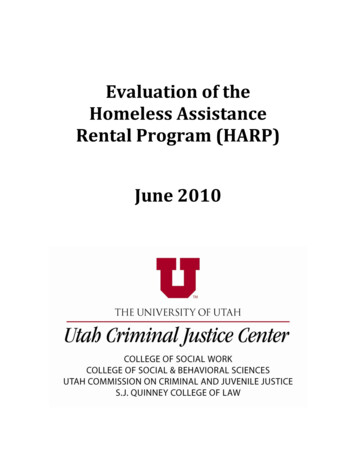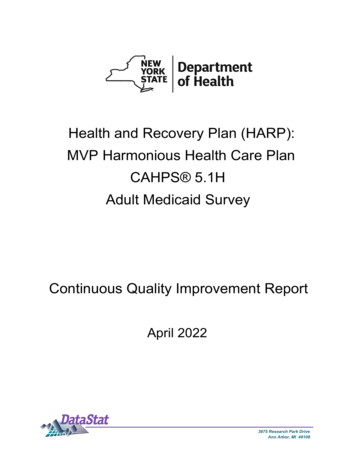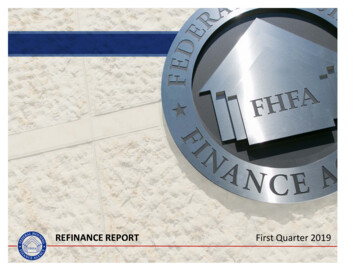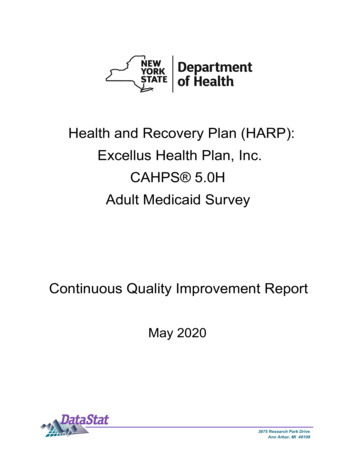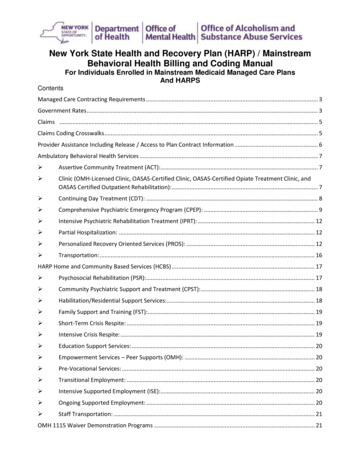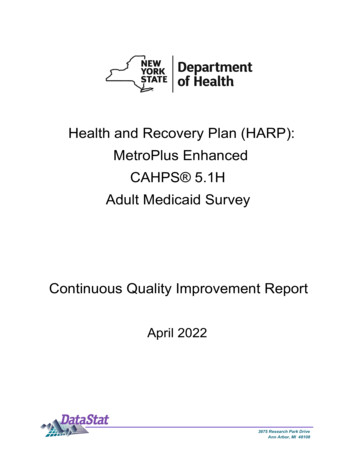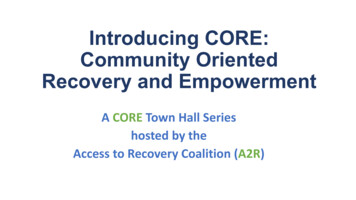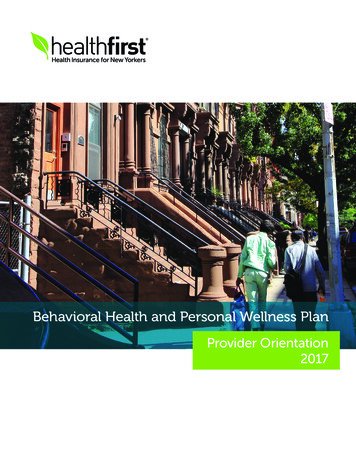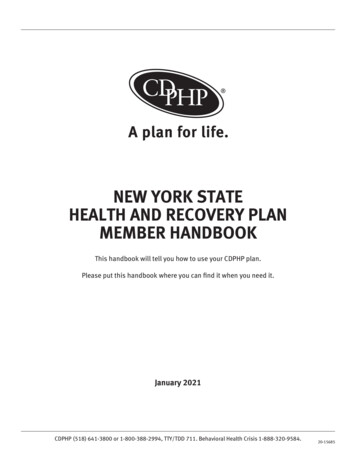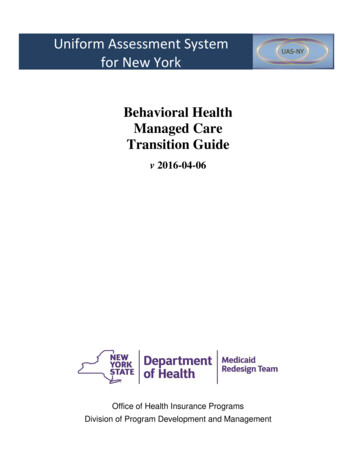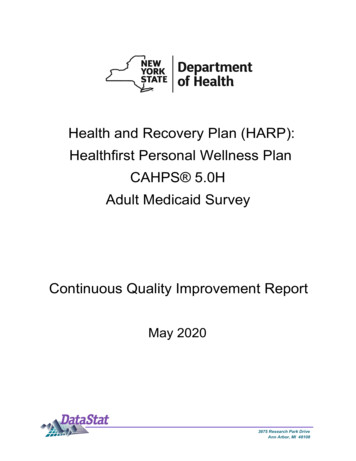
Transcription
Health and Recovery Plan (HARP):Healthfirst Personal Wellness PlanCAHPS 5.0HAdult Medicaid SurveyContinuous Quality Improvement ReportMay 20203975 Research Park DriveAnn Arbor, MI 48108
Healthfirst Personal Wellness PlanTable of ContentsBackground1Executive Summary22345678Standard RatingsStandard CompositesKey Measure SummarySample ProfileSample DispositionResponse Rate ReportTrend AnalysisMethodology9IntroductionSurvey MilestonesSampling FrameQuestionnaireSelection of Cases for AnalysisDefinition of Achievement ScoresCompositesCorrelation to SatisfactionComparisonsStatistical TestingCase-Mix AnalysisUsing This Report12Graphs/Results1415203841Standard RatingsStandard CompositesMedical Assistance with Smoking CessationSingle ItemsCorrelation AnalysisHealthfirst Personal Wellness PlanRating Question DetailsResponses by Question60616267Appendix A: QuestionnaireNew York State Department of Health DataStat, Inc.
Healthfirst Personal Wellness PlanBackgroundBackgroundIn New York, Medicaid enrollees living with significant behavioral health needs may be enrolled in a type ofMedicaid managed care plan called a Health and Recovery Plan (HARP). These plans are designed tospecifically address the needs of members living with mental health or substance use disorders byproviding access to experienced behavioral health providers and offering services specialized for theirneeds. Specialized services include care coordination between medical and other providers, promotingwellness, and treatment adherence services.The Consumer Assessment of Healthcare Providers and Systems (CAHPS ) survey is a comprehensivetool designed to assess consumers' experience with health care and health plans. CAHPS is thequestionnaire that asks health plan members about experiences with access to care, health care providersand health plans. The New York State Department of Health (NYSDOH) sponsors a CAHPS surveyevery other year for the Medicaid managed care plans and uses the results to determine variation inmember satisfaction among the plans. DataStat, Inc. conducted the survey on behalf of the NYSDOH in2019. The instrument used for the administration of the survey was the CAHPS 5.0H Adult Medicaid coresurvey, developed and tested nationally for assessing the performance of health plans.The majority of question items addressed member's experience with their health care, such as getting carequickly, communication with doctors, and overall satisfaction with health care and with the health plan. Thequestionnaire was expanded to include 22 supplemental questions of particular interest to the NYSDOH.Rounding out the instrument was a set of questions collecting demographic data. In total, thequestionnaire consisted of 67 questions. A copy of the modified CAHPS questionnaire can be found inAppendix A.Copyright Notice: DataStat has created the format and organization of this report and retains that as its sole property, holds the copyrighton that portion of the report and conveys no interest in that portion of the report. Users of this report expressly agree not to copy orotherwise disseminate the format or organization which are DataStat's sole property without DataStat's written permission.CAHPS is a registered trademark of the Agency for Healthcare Research and Quality (AHRQ).New York State Department of HealthPage 1 DataStat, Inc.
Healthfirst Personal Wellness PlanExecutive SummaryExecutive SummaryIn New York, the CAHPS survey is administered to Medicaid managed care plan members every other year.For the 2019 administration, the NYSDOH focused on adult members of Medicaid managed care plans as wellas members in Special Needs Plans (SNPs) and Health and Recovery Plans (HARPs). The survey included13 HARPs in New York with a sampled goal of 1,500 adults per plan. Questionnaires were sent to 19,299members following a mail only methodology during the period October 3, 2019, through December 31, 2019,using a standardized survey procedure and questionnaire. A total of 276 responses were received resulting ina 18.5% response rate. The disposition of surveys is contained at the end of this section.Conclusions based on the information presented in this report should be tempered by a few caveats. First, forsome questionnaire items, relatively small numbers of responses may be available due to skip patterns in thequestionnaire. In order to present the most reliable information, results based on fewer than 30 observationsare not presented in this report. Second, in some of the data presentations included in this report, correlationcoefficients are computed to explore the relationship between different measures. High correlations, however,do not necessarily indicate causation. Finally, in many of the graphs and tables presented in this report,differences between the Statewide average and individual managed care plans are readily apparent. However,where these differences are not statistically significant they should be evaluated accordingly.Summary of Standard Rating QuestionsResponse options for standard rating questions ranged from 0 (worst) to 10 (best). In the table below, theachievement score represents the proportion of members who responded with a rating of "8", "9", or "10".HARP results are presented for Statewide, New York City (NYC), Rest of State and the plan. Plan results arecompared to the HARP Statewide achievement scores and a significance level of .05 or less was consideredstatistically significant and "é" or " ê" is placed at the top of the appropriate bar. Regional results are presentedfor additional information, but are not compared to the Statewide achievement scores.BetterStandard Ratings Questions (8, 9 or 10)10090807060504030Worse20100HARP Statewide 2019NYC 2019Rest of State 2019Healthfirst 2019éêQ21. Rating of allhealth careQ37. Rating ofpersonal doctorQ41. Rating ofspecialist seenmost oftenQ48. Rating ofhealth planQ25. Rating oftreatment 7%72.71%66.07%66.87%65.76%67.54%Statistically significantly better/worse than HARP Statewide 2019.New York State Department of HealthPage 2 DataStat, Inc.
Healthfirst Personal Wellness PlanExecutive SummarySummary of Standard CompositesA composite score is calculated for each of five domains of member experience: Getting Needed Care, GettingCare Quickly, How Well Doctors Communicate, Customer Service and Shared Decision Making. Compositeachievement scores indicate the proportion of members who reported a positive experience within a givendomain. Responses of "Usually" or "Always" indicate achievement for all composite measures except forShared Decision Making, which uses "Yes" as the indicator of achievement. HARP results are presented forStatewide, New York City (NYC), Rest of State and the plan. Plan results are compared to the HARPStatewide achievement scores and a significance level of .05 or less was considered statistically significantand "é" or " ê" is placed at the top of the appropriate bar. Regional results are presented for additionalinformation, but are not compared to the Statewide achievement scores.BetterStandard Composites1009080ê7060504030Worse20100HARP Statewide 2019NYC 2019Rest of State 2019Healthfirst 2019éêGetting NeededCare (Usually orAlways)Getting CareQuickly (Usuallyor Always)How Well DoctorsCommunicate(Usually orAlways)Customer Service(Usually orAlways)Shared DecisionMaking %81.39%79.49%82.64%72.58%Statistically significantly better/worse than HARP Statewide 2019.New York State Department of HealthPage 3 DataStat, Inc.
Healthfirst Personal Wellness PlanExecutive SummaryKey Measure SummaryPlansGettingNeededCare(Usually orAlways)GettingHow ally or te (Usually (Usually orAlways)or Always)Always)SharedDecisionMaking(Yes)Rating ofall healthcareRating ofpersonaldoctorRating ofspecialistseen mostoftenRating ofhealth planRating oftreatmentorcounselingHARP 67Rest of State82849085836977787166Affinity Enriched 0Empire80819389816878706967Excellus Health Plan,Inc.79839190867276797559Fidelis HealthierLife80859186837081767267Healthfirst PersonalWellness Plan80849282736881767368HIP EmblemHealth82828982807280757567Independent Health80849088836775777567MetroPlus Enhanced76808986776880737566Molina HealthcarePLUS79768679835973725757MVP 8981827077756862YourCare Options Plus85848983827075797473Statistically significantly better/worse than HARP Statewide 2019.New York State Department of HealthPage 4 DataStat, Inc.
Healthfirst Personal Wellness PlanExecutive SummaryRespondent Sample ProfileRest of StateHealthfirst PersonalWellness 5 to 5425.6%23.9%26.7%29.1%55 to 6445.6%48.2%43.5%46.3%65 to 743.1%3.4%2.8%4.9%75 or older0.2%0.3%0.2%0.0%HARP StatewideNYCRest of StateHealthfirst PersonalWellness 0.9%HARP StatewideNYCRest of StateHealthfirst PersonalWellness Plan8th grade or less11.6%15.1%9.2%17.2%Some high school, but did not graduate25.4%29.3%22.7%28.7%High school graduate or GED31.8%28.9%33.8%30.6%Some college or 2-year degree23.5%19.5%26.4%17.2%4-year college graduate5.1%4.1%5.7%3.0%More than 4-year college graduate2.6%3.1%2.2%3.4%Hispanic or LatinoHARP StatewideNYCRest of StateHealthfirst PersonalWellness PlanYes, Hispanic or Latino27.5%44.2%15.5%44.2%No, Not Hispanic or Latino72.5%55.8%84.5%55.8%RaceHARP StatewideNYCRest of StateHealthfirst PersonalWellness PlanWhite52.1%29.4%67.7%28.1%Black or .6%4.0%Native Hawaiian or Other Pacific Islander0.6%0.4%0.7%0.4%American Indian or Alaska Native2.9%2.4%3.3%3.2%18.2%29.6%10.3%26.9%HARP StatewideNYCRest of StateHealthfirst PersonalWellness PlanExcellent7.3%9.0%6.0%9.9%Very ir35.5%35.9%35.2%38.4%Poor12.7%11.8%13.1%12.5%Age (years)HARP StatewideNYC18 to 241.3%25 to 349.5%35 to 44GenderHighest grade or level of school completedOtherRating of Overall HealthNew York State Department of HealthPage 5 DataStat, Inc.
Healthfirst Personal Wellness PlanExecutive SummarySample DispositionHARP StatewideFirst mailing - sentHealthfirst Personal 914276796Ineligible: Language barrier†30Ineligible: Deceased†80Ineligible: Mentally or physically unable to completesurvey†181Refusal/Returned survey blank344Incomplete survey - mail or phone95913,8451,0340015.2%18.5%First mailing - usable survey returned*Second mailing - sentSecond mailing - usable survey returned*Total - usable surveysIneligible: According to population criteria‡†Nonresponse - Unavailable by mail or phoneAdded to Do Not Call listResponse Rate*Included in response rate numerator†Excluded from response rate denominator‡Population criteria: The designated respondent must be a member of the managed care plan.Note: Response Rate Total Usable Surveys / Total Eligible CasesNew York State Department of HealthPage 6 DataStat, Inc.
Healthfirst Personal Wellness PlanExecutive SummaryResponse RatesResponseRateUsableSurveysHARP 2530354045505560HARP Statewide 2019New York State Department of Health65707580859095100BetterResponse RateHealth Plans 2019Page 7 DataStat, Inc.
Healthfirst Personal Wellness PlanTrend AnalysisTrend Analysis - 2019 vs. 2017The table below provides a snapshot of the items with the greatest point change, positive or negative,since 2017. All performance-related items in the questionnaire that were trendable were listed indescending order of point change, and testing was conducted to determine which trends were statisticallysignificant. Two questions (Questions 8 and 10) cannot be trended and are not included in this analysis.Shown below are the ten items at the top of the list and the ten items at the bottom, with their 2017 and2019 scores and results of the significance testing. In the table presented below, differences over timemay be readily apparent. However, where these differences are not statistically significant they should beevaluated accordingly.Healthfirst2019 ScoreHealthfirst2017 ScorePointChangeComposite/Question GroupQ4. Usually or always got care right away as soon as you needed86.8%78.3% 8.5Getting CareQuicklyQ13d. Doctor or other health provider talked about whether therewas a period of time when you felt sad, empty or depressed77.1%69.7% 7.5Single ItemsQ13b. Doctor or other health provider talked about exercise orphysical activity77.7%70.8% 6.9Single ItemsQ20. Results of blood test, x-ray or other test usually or alwayseasy to understand82.1%75.2% 6.8Single ItemsQ36. Personal doctor usually or always seemed informed aboutcare received from other doctors or providers88.8%82.0% 6.8Single ItemsQ33. Personal doctor usually or always showed respect for whatyou had to say94.7%88.1% 6.6CommunicationQ39. Usually or always get an appointment to see a specialist assoon as you needed76.4%70.2% 6.2Getting NeededCareQ32. Personal doctor usually or always listened carefully to you92.8%86.7% 6.1CommunicationQ37. Rating of personal doctor80.5%74.7% 5.9RatingsQ34. Personal doctor usually or always spent enough time with you90.0%84.8% 5.2CommunicationQ19. Someone from doctor's office usually or always followed up togive blood test, x-ray or other test results79.2%82.5%- 3.2Single ItemsQ48. Rating of health plan72.7%77.5%- 4.8RatingsQ13c. Doctor or other health provider talked about things in yourlife that worry you or cause you stress76.1%80.9%- 4.8Single ItemsQ25. Rating of treatment or counseling67.5%72.5%- 5.0RatingsQuestionQ22. Usually or always got care, tests or treatment, you thoughtyou needed82.8%88.1%- 5.3Getting NeededCareQ45. Health plan's customer service usually or always gave neededinformation or help74.3%80.2%- 5.9Customer ServiceQ12. Doctor/provider definitely talked about specific things to do toprevent illness77.4%84.0%- 6.5Single ItemsQ17. Doctor/provider asked what you thought was best for you73.7%81.7%- 8.0Shared DecisionMakingQ52. Had flu shot or flu spray since September 1, 2018? [Displayedfor Respondents 18-64 years old]48.4%62.0%- 13.6Single ItemsQ16. Doctor/provider talked about reasons you might not want totake a medicine52.7%67.8%- 15.2Shared DecisionMakingStatistically significantly higher/lower than 2017 score.New York State Department of HealthPage 8 DataStat, Inc.BetterWorse
Healthfirst Personal Wellness PlanMethodologyMethodologyAdults who were current members of a NYSDOH HARP, ages 21 to 64, as of September 2019 and who hadbeen enrolled for five out of the last six months were eligible to be randomly selected for the survey.Respondents were surveyed in English or Spanish. The survey was administered over a 12 week period usinga mail only three wave protocol. The protocol consisted of a first questionnaire packet and reminder postcardto all selected members, followed by a second questionnaire packet to individuals who had not responded tothe initial mailings.Survey Milestones1. 1st questionnaire packets mailed: October 3, 20192. Reminder postcards mailed: October 10, 20193. 2nd questionnaire packets mailed: November 7, 20194. Field closed: December 31, 2019Sampling FrameA stratified random sample was drawn with the goal of selecting 1,500 eligible adults for each of the HARPs.To be eligible, individuals had to be current members, aged 21 to 64, who were continuously enrolled in theplan for at least five out of the last six months as of September 2019.QuestionnaireThe instrument selected for the survey, the CAHPS 5.0H Adult Medicaid core survey, was developed andtested nationally for use in assessing the performance of health plans. The majority of questions addresseddomains of member experience such as getting care quickly, doctor communication, overall satisfaction withhealth care and health plan. The questionnaire was expanded to include 22 supplemental questions ofparticular interest to the NYSDOH. Rounding out the questionnaire was a set of questions collectingdemographic data. In total, the questionnaire consisted of 67 questions. A copy of the modified CAHPS questionnaire can be found in Appendix A.Selection of Cases for AnalysisQuestionnaires were considered complete if respondents did not say 'No' to Question 1 (Our records showthat you are now in [HEALTH PLAN NAME]. Is that right?) and if they provided a valid response to at leastthree of the five questions: Q3, Q29, Q38, Q44, Q48. Complete interviews were obtained from 276 NYSDOHHARP members, and the overall project response rate was 18.5%.Definition of Achievement ScoresMember responses to questionnaire items are summarized as achievement scores. Responses that indicate apositive experience are labeled as achievements, and an achievement score is computed equal to theproportion of responses qualifying as achievements. Since achievement scores for questions represent theproportion of respondents who indicate a positive experience, the lower the achievement score, the greaterthe need for improvement. See the Responses by Question section for assignment of achievement responsesfor each question.In general, somewhat positive responses are included with positive responses as achievements. For example,a response of "Usually" or "Always" to the question "How often did you get an appointment for health care at adoctor's office or clinic as soon as you needed?" is considered an achievement, as are responses of "8", "9",or "10" to rating questions.New York State Department of HealthPage 9 DataStat, Inc.
Healthfirst Personal Wellness PlanMethodologyCompositesFive standard composite scores summarize responses in key areas: Getting Needed Care, Getting CareQuickly, How Well Doctors Communicate, Customer Service, and Shared Decision Making. The achievementscore for the composite is the average of the achievement scores for the individual items comprising acomposite. Following is a list of the questions that comprise each composite:Getting Needed CareQ22. Usually or always got care, tests or treatment, you thought you neededQ39. Usually or always get an appointment to see a specialist as soon as you neededGetting Care QuicklyQ4. Usually or always got care right away as soon as you neededQ6. Usually or always got an appt. for check-up or routine care as soon as you neededHow Well Doctors CommunicateQ31.Q32.Q33.Q34.Personal doctor usually or always explained things in way that was easy to understandPersonal doctor usually or always listened carefully to youPersonal doctor usually or always showed respect for what you had to sayPersonal doctor usually or always spent enough time with youCustomer ServiceQ45. Health plan's customer service usually or always gave needed information or helpQ47. Usually or always treated with courtesy and respect by health plan's customer service staffShared Decision MakingQ15. Doctor/provider talked about reasons you might want to take a medicineQ16. Doctor/provider talked about reasons you might not want to take a medicineQ17. Doctor/provider asked what you thought was best for youCorrelation to SatisfactionTo understand the relationship between performance and satisfaction in particular areas of memberexperience, correlations are computed between responses to the question items comprising the fivecomposites and each of the ratings questions. The specific correlation computed is Pearson's CorrelationCoefficient, which takes on values between -1 to 1. Correlation scores are presented in the CorrelationAnalysis section.Comparisons: Current Year and TrendingTwo types of comparisons are presented. Current year comparisons are found in the Executive Summary andGraphs sections. In the Executive Summary section, plan level results for the Standard Ratings andComposites are compared to the Statewide achievement score, with statistical testing. Regional results arepresented for comparison. In the Graphs section plan level results for each performance measure arecompared to the Statewide achievement score, with statistical testing. Regional results are presented foradditional information, but are not compared to the Statewide achievement scores.Comparisons across time are the focus of the Trend Analysis section: all performance-related items in thequestionnaire that were trendable were listed in descending order of point change. The Trend Analysis sectiondisplays, for the plan, the ten items at the top of the list and the ten items at the bottom, with the 2017 and2019 scores and results of significance testing. In addition, in the Responses by Question section, for eachperformance item, the achievement score point change is displayed along with results of significance testing.New York State Department of HealthPage 10 DataStat, Inc.
Healthfirst Personal Wellness PlanMethodologyStatistical TestingStatistically significant differences between scores were determined using t-tests. A significance level of .05 orless was considered statistically significant and "é" or " ê" is placed at the top of the appropriate bar or next tothe appropriate achievement score.Case-Mix AnalysisThe majority of achievement scores presented in this report are case-mix adjusted to control for differences inthe member population across managed care plans. The results for 2019 are case-mix adjusted for age (Q60),health status (Q50) and education (Q62). Case-mix adjustment is applied to mitigate the effect of differencesin individual plan's member population. The variables chosen for case-mix adjustment are beyond the controlof the managed care plan and have been shown to affect managed care plan and health care ratings. Forexample, individuals with higher levels of education generally rate lower for satisfaction. Details about thedistribution of populations in categories for the three adjusters can be seen in the Respondent Sample Profilecontained in the Executive Summary section.All achievement scores based on questions in the "About Your Health" and "About You" sections are not casemix adjusted. Case-mix adjustment is also not applied to the achievement scores for the Question 13 series.New York State Department of HealthPage 11 DataStat, Inc.
Healthfirst Personal Wellness PlanUsing this reportUsing this ReportUnderstanding Achievement ScoresThis report is designed to assist the NYSDOH and participating health plans in identifying key opportunities toimprove members' experiences. Member responses to questions are summarized as achievement scores.Responses that indicate a positive experience are labeled as achievements, and an achievement score is computedas the proportion of responses qualifying as positive. Responses of "Yes" are considered achievements for theShared Decision Making composite. For all other composites, responses of "Usually" or "Always" are consideredachievements. For example, a response of "Usually" or "Always" to the question "How often did you get care as soonas you needed?" is considered a positive response, and the achievement score for this question is equal to theproportion of respondents who answered the question with "Usually" or "Always". Because achievement scores forquestions are computed as the proportion of members who indicate a positive experience, the lower the achievementscore, the greater the need to improve.Achievement scores are computed and reported for all pertinent questions. In addition, composite scores are builtfrom groups of questions that make up broad domains of members' experience: Getting Needed Care, Getting CareQuickly, How Well Doctors Communicate, Customer Service, and Shared Decision Making.Achievement scores based on fewer than 30 observations are suppressed in this report and "NA" is substituted forthe result. When relevant, a footnote is presented. Typically, too few responses are due to skip patterns in thequestionnaire. Suppressing scores based on a small number of cases ensures that this report includes the mostreliable information available.Understanding the Sections of the ReportThe CAHPS survey results are presented here in a format that is optimized for use in practical decision-making.Specifically, these reports can:1. Assist the NYSDOH and health plans in identifying strengths and weaknesses in quality of healthcare, access and services, and2. Provide the NYSDOH and health plans with a way to assess where resources can best be allocatedto improve experiences.The remainder of the report is broken into three major sections that are briefly described here to help you make thebest use of the report and the information it contains.Graphs/ResultsThis section contains a graphic presentation of the HARP Statewide, NYC, Rest of State and plan specific results forquestions using the achievement scores. Statistical significance, the achievement score, and the number ofrespondents for each plan are displayed. This depicts plan specific performance compared to the HARP Statewideand peers. The composites are directly followed by the individual questions that are combined to create compositemeasures.Correlation AnalysisThe Correlation Analysis section is helpful in understanding how satisfaction in various questions relates to the fourstandard rating questions (personal doctor, specialist seen most often, all health care, and health plan) forrespondents. The charts show which questions are most strongly linked to the rating and the current achievementscore. The information helps define what areas are related to satisfaction and how the plan performed in that area.The section enables a quick view of how composite questions correlate across ratings.The correlation analyses are presented two ways. First there are correlations of the top ten highly correlatedcomposite questions to the four rating questions ranked by the highest correlation between the question and rating.This allows a visual picture of clustering of composites across ratings. The second analysis presents the proportionNew York State Department of HealthPage 12 DataStat, Inc.
Healthfirst Personal Wellness PlanUsing this reportof responses in each response option for each composite question for each individual rating. This lets you see wherethere may be an opportunity for improvement. For example, if a question correlates highly and has higher proportionsof "usually" and "sometimes", improving the processes may move respondents up to "always" to improve not onlythat composite, but the other rating questions.Responses by QuestionThis section provides a breakdown for each question with the number of members responding to the question andthe distribution for each available response option. For each question that has responses determined to be positiveor negative, there is a colored circle indicating achievement (green circle) or room for improvement (red circle). Thecircles are based on the response category and are not indicative of areas the plan needs to improve necessarily.For example, "Always" and "Usually" are achievement and "Sometimes" and "Never" are room for improvement.Similarly on a rating question, "8", "9", or "10" are achievement and 0 through 7 are room for improvement.Questions without a colored circle indicate the question is not associated with this type of response determination.For example, asking whether a member needed a service in the past six months does not have an associatedachievement score. Achievement scores based on fewer than 30 observations are suppressed and "NA" issubstituted for the result. This section provides additional information about volume of members to help you prioritizeareas to be addressed.When applicable, each question is represented with the composite name, the achievement score, the correlation withrating of health plan and trend information. The achievement scores are case-mix adjusted while data for eachresponse option are not case-mix adjusted. Achievement scores for the Question 13 series, the "About Your Health"and "About You" sections are not case-mix adjusted.New York State Department of HealthPage 13 DataStat, Inc.
Healthfirst Personal Wellness PlanOverall RatingsGraphs/ResultsThe Graphs/Results sections contains a graphic presentation of the HARP Statewide, NYC, Rest of State andplan specific results for each question using the achievement scores. Statistical significance, the achievementscore, and the number of respondents for each plan are displayed. This depicts plan specific performancecompared to various benchmarks or peers. Rating results are followed by composites and the questions thatmake up each composite. Medical Assistance with Smoking Cessation and Single Items can be found at theend of this section.The CAHPS 5.0H survey uses a 0-10 rating for assessing overall experience with personal doctors,specialists, health care and health plans. In the four ratings graphs, proportions of respondents assigningratings of "8", "9", or "10" are reported as achievement scores.Questions that relate to the same broad domain of performance are grouped together for the purpose ofreporting. For example, the domain "Getting Care Quickly" includes questions about how soon appointmentswere scheduled. Composite achievement scores reflect responses of "Usually" or "Always" for the first fourcomposites. Responses of "Yes" are considered achievements for the Shared Decision Making composite.Graphs presenting the results of individual questions that make up the composite score follow the presentationof t
Health and Recovery Plan (HARP): Healthfirst Personal Wellness Plan CAHPS 5.0H Adult Medicaid Survey Continuous Quality Improvement Report . Excellus Health Plan, Inc. 79 83 91 90 86 72 76 79 75 59 Fidelis HealthierLife 80 85 91 86 83 70 81 76 72 67 Healthfirst Personal Wellness Plan
